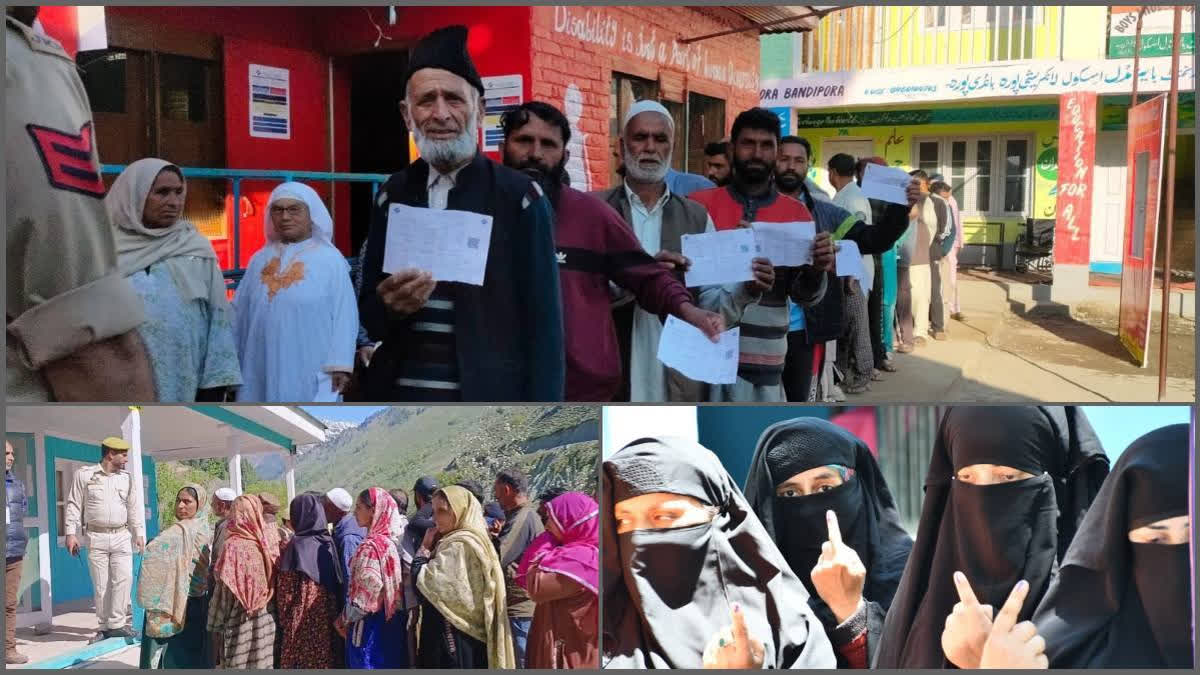Srinagar:In the fifth phase of the Lok Sabha Elections 2024, the Baramulla parliamentary constituency recorded a historic voter turnout of around 60 per cent on Monday, marking its highest turnout since the 1967 parliamentary elections. Out of over 17.38 lakhs eligible voters, approximately 10.43 lakhs cast their votes for the 22 candidates vying for a seat in Parliament.
Addressing a press conference in Srinagar soon after the polls concluded on May 20, Chief Electoral Officer (Jammu & Kashmir) Pandurang K Pole stated, "Overall, polling remained peaceful, with no negative incidents reported throughout the day. The situation has improved significantly over the last four years, contributing to the high voter turnout in this election. Notably, Sopore, which previously never saw turnout exceed single digits, experienced a substantial increase. Compared to just 4% in 2019, today's voter turnout in Sopore was recorded at 44.36%."
"In 1967, Baramulla recorded a voter turnout of 51.35%. This was followed by 50.62% in 1971, 56.97% in 1977, 56.02% in 1980, 59.09% in 1984, 5.48% in 1989, no election in 1991, 46.65% in 1996, 41.94% in 1998, 27.79% in 1999, 35.65% in 2004, 41.84% in 2009, 38.96% in 2014 and 37.41% in 2019. This year, Baramulla broke all previous records by registering a voter turnout of around 60%."
Detailing the voter turnout, Pole said, "Handwara recorded the highest turnout among the Assembly segments at 67.50%, followed by Langate at 66% and Sonawari at 64.61%. In Kupwara district, Trehgam saw a turnout of 61.17%, Kupwara recorded 58.90%, and Lolab had 58%. In Baramulla district, Rafiabad recorded 57.39%, Uri 60.27%, Baramulla 49.34%, Gulmarg 58.50%, Wagoora 49.79%, and Pattan 59.87%. In Bandipora district, Gurez recorded 40.82%, and Bandipora had 60.24%. In Budgam district, Beerwah recorded 56.63%, while Budgam saw 51.76%."
"Migrant voters' turnout was also notable. Out of 22,000 registered migrant voters, 32 per cent cast their votes today. Additionally, 5,481 postal votes were received," he added.
The high-stakes contest in Baramulla drew 22 candidates from various political parties. Notable contenders included former Chief Minister and National Conference (NC) Vice-President Omar Abdullah, former minister and People's Conference (PC) President Sajad Gani Lone, Independent candidate Engineer Rashid and People's Democratic Party's (PDP) Muhammad Fayaz Mir.
Authorities had established 2,103 polling stations in the Baramulla parliamentary constituency, with 905 booths in the Baramulla district alone identified as critical. These polling stations were equipped with 4,206 CCTV cameras for live webcasting, along with 50 additional cameras, at the main entrances.
The Baramulla constituency encompasses 18 Assembly segments, including six in Kupwara (Karnah, Trehgam, Kupwara, Lolab, Handwara, and Langate), seven in Baramulla (Sopore, Rafiabad, Uri, Baramulla, Gulmarg, Wagoora-Kreeri, and Pattan), three in Bandipora (Sonwari, Bandipora and Gurez), and two in Budgam post-delimitation.
Security measures were stringent, with extensive monitoring via CCTV and drone surveillance. Around 200 additional companies of the Central Armed Police Forces (CAPF) were deployed. Since 1957, Baramulla has witnessed the representation of 11 different members in the Indian Parliament. The political landscape of Baramulla has seen notable diversity in terms of party affiliations over the years.
In 1957, Shaikh Mohammed Akbar of the Indian National Congress became the first representative, marking the beginning of its parliamentary journey. The subsequent elections in 1967 and 1971 maintained the Congress stronghold with Syed Ahmed Aga securing victory both times.
The political dynamics shifted in 1977 when Abdul Ahad Vakil of the Jammu & Kashmir National Conference emerged victorious, indicating a shift in the political winds of Baramulla. However, this change was short-lived as Khwaja Mubarak Shah from the Indian National Congress regained the seat in 1980.
The 1980s saw a seesaw battle between the Congress and the Jammu & Kashmir National Conference. Saifuddin Soz became a prominent figure, representing the National Conference in 1983, 1984, and 1989. This period marked a significant back-and-forth between the two major parties.
